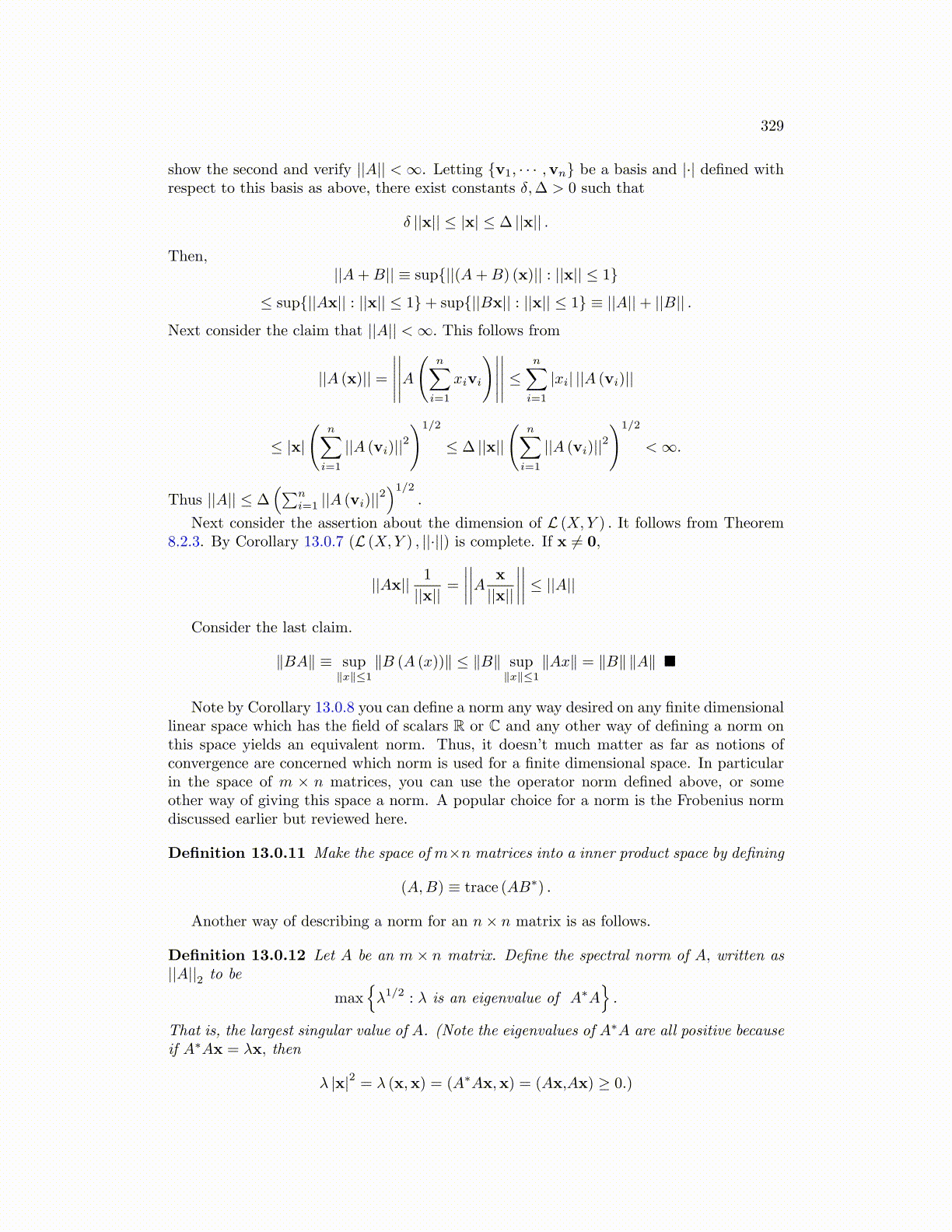
329
show the second and verify ||A|| <∞. Letting {v1, · · · ,vn} be a basis and |·| defined withrespect to this basis as above, there exist constants δ,∆ > 0 such that
δ ||x|| ≤ |x| ≤ ∆ ||x|| .
Then,||A+B|| ≡ sup{||(A+B) (x)|| : ||x|| ≤ 1}
≤ sup{||Ax|| : ||x|| ≤ 1}+ sup{||Bx|| : ||x|| ≤ 1} ≡ ||A||+ ||B|| .
Next consider the claim that ||A|| <∞. This follows from
||A (x)|| =
∣∣∣∣∣∣∣∣∣∣A(
n∑i=1
xivi
)∣∣∣∣∣∣∣∣∣∣ ≤
n∑i=1
|xi| ||A (vi)||
≤ |x|
(n∑
i=1
||A (vi)||2)1/2
≤ ∆ ||x||
(n∑
i=1
||A (vi)||2)1/2
<∞.
Thus ||A|| ≤ ∆(∑n
i=1 ||A (vi)||2)1/2
.
Next consider the assertion about the dimension of L (X,Y ) . It follows from Theorem8.2.3. By Corollary 13.0.7 (L (X,Y ) , ||·||) is complete. If x ̸= 0,
||Ax|| 1
||x||=
∣∣∣∣∣∣∣∣A x
||x||
∣∣∣∣∣∣∣∣ ≤ ||A||
Consider the last claim.
∥BA∥ ≡ sup∥x∥≤1
∥B (A (x))∥ ≤ ∥B∥ sup∥x∥≤1
∥Ax∥ = ∥B∥ ∥A∥ ■
Note by Corollary 13.0.8 you can define a norm any way desired on any finite dimensionallinear space which has the field of scalars R or C and any other way of defining a norm onthis space yields an equivalent norm. Thus, it doesn’t much matter as far as notions ofconvergence are concerned which norm is used for a finite dimensional space. In particularin the space of m × n matrices, you can use the operator norm defined above, or someother way of giving this space a norm. A popular choice for a norm is the Frobenius normdiscussed earlier but reviewed here.
Definition 13.0.11 Make the space of m×n matrices into a inner product space by defining
(A,B) ≡ trace (AB∗) .
Another way of describing a norm for an n× n matrix is as follows.
Definition 13.0.12 Let A be an m× n matrix. Define the spectral norm of A, written as||A||2 to be
max{λ1/2 : λ is an eigenvalue of A∗A
}.
That is, the largest singular value of A. (Note the eigenvalues of A∗A are all positive becauseif A∗Ax = λx, then
λ |x|2 = λ (x,x) = (A∗Ax,x) = (Ax,Ax) ≥ 0.)